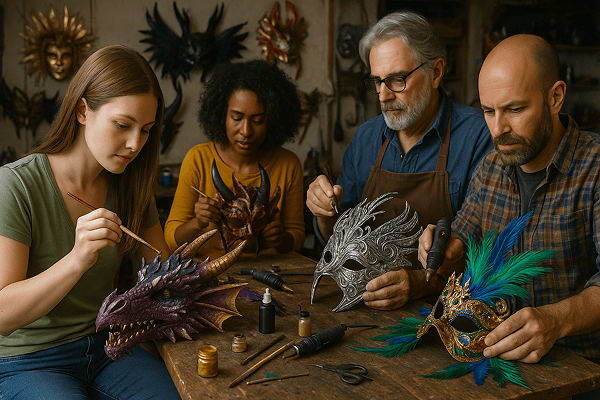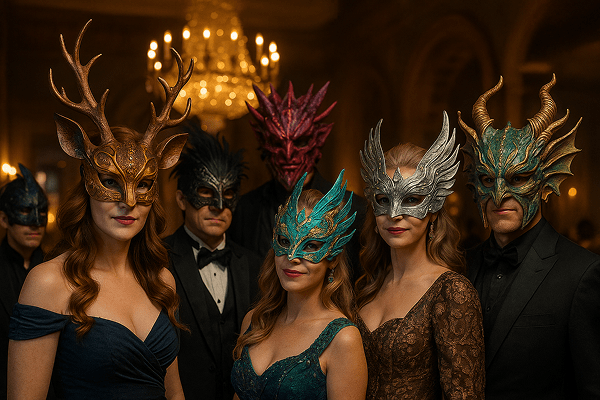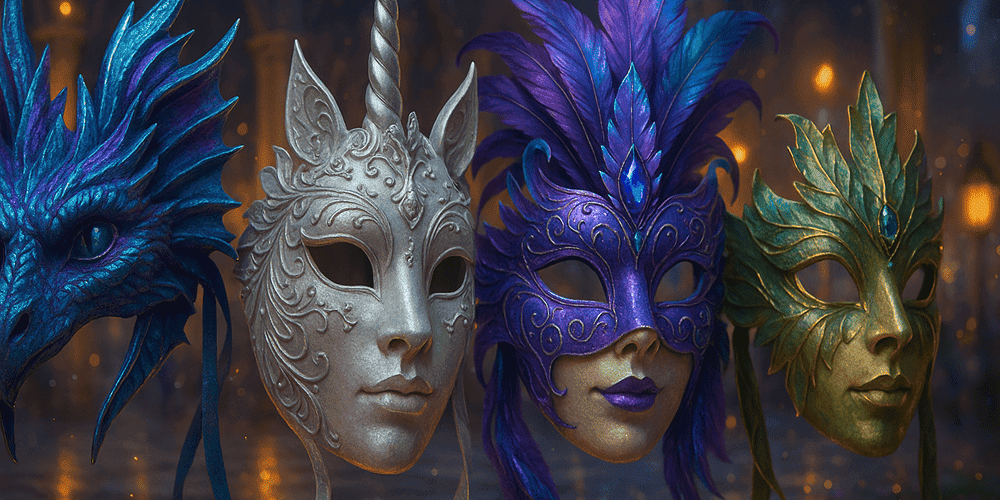Fantasy Masks for masquerade balls — often referred to as Fantasy Masquerade Masks — are imaginative, dramatic, and visually stunning accessories that transport their wearers and viewers into realms of myth, legend, and the supernatural. Unlike traditional Ball Masks, Fantasy Masks are distinguished by their extravagant forms, elaborate decorations, and motifs drawn from fantasy literature, fairy tales, and world folklore. These masks may depict mythical creatures (dragons, unicorns, phoenixes), enchanted spirits, or characters from medieval and fantastical worlds. While rooted in the grand European masquerade traditions of the Renaissance and Baroque periods, Fantasy Masks are now a global phenomenon, appearing in cultural festivals, themed parties, and fantasy conventions worldwide.
Historical Origins of Fantasy Masquerade Masks
The concept of Fantasy Masks evolved from the historical use of masks in ritual, theater, and courtly entertainment. The term “fantasy” comes from the Greek “phantasia,” meaning imagination or apparition, reflecting the mask’s purpose to evoke otherworldly personas. While early masquerade masks in Venice, France, and England primarily featured classical or stock characters, by the 18th and 19th centuries, artists began experimenting with more imaginative designs, inspired by fairy tales, Gothic novels, and Romantic art.
The development of fantasy-themed masks accelerated with the rise of fantasy literature and theater in the 19th and 20th centuries. Major historical milestones include the popularity of fairy tale balls in Victorian England and the influence of Art Nouveau and Art Deco aesthetics. Today, Fantasy Masks are celebrated at masquerade balls, Renaissance fairs, and comic conventions, with many examples preserved in museum collections and private galleries.
Cultural Significance and Symbolism of Fantasy Masks
Fantasy Masquerade Masks carry rich symbolic meaning in the cultures that embrace them. They represent transformation, escapism, and the limitless potential of the imagination. Wearing such a mask allows individuals to embody mythic archetypes, engage in magical role-play, or explore alternate identities in a safe, festive context.
Spiritually, Fantasy Masks often reference ancient legends, magical rites, and supernatural beings. In some cultures, they are linked to protective or transformative powers, echoing the mythic role of masks in shamanic rituals. Socially, these masks encourage playfulness, theatricality, and creative expression, breaking down boundaries between reality and fantasy. Myths and stories — from dragon-slaying heroes to enchanted forests — are often woven into the design and use of Fantasy Masks, enriching the narrative of masquerade events.
Materials and Crafting Techniques of Fantasy Masks
Traditional and modern Fantasy Masks are created from a variety of materials, chosen for their versatility and decorative potential. Common materials include papier-mâché, leather, resin, plastic, lightweight metal, foam, and even 3D-printed polymers. Artisans often use sculpting, molding, and carving techniques to create dramatic shapes — from elongated snouts and horns to sweeping wings and elaborate filigree.

Decoration is where Fantasy Masks truly shine. Techniques include hand-painting, airbrushing, gilding, beading, featherwork, and the application of crystals, sequins, lace, and LED lights. Tools such as sculpting knives, rotary tools, glue guns, and paintbrushes are essential. Regional variations exist: Italian fantasy masks may echo Venetian traditions with gold leaf and baroque motifs, while American or Asian masks might integrate steampunk, cyberpunk, or anime influences. Color symbolism is significant — iridescent and metallic hues suggest otherworldliness, while bold colors evoke magic and transformation.
For tutorials and artisan interviews, toddmasks.com features exclusive content on Fantasy Mask creation.
Functions and Uses of Fantasy Masquerade Masks
Fantasy Masks are worn for a wide range of purposes. In masquerade balls, they provide a vehicle for self-expression and transformation, allowing guests to embody magical creatures or legendary characters. In theater and performance, Fantasy Masks are used to represent supernatural beings, gods, and monsters, enhancing the drama and spectacle of the stage.
At festivals, fairs, and themed parties, Fantasy Masks encourage playful interaction, creative storytelling, and group identity. Their use has expanded to include cosplay conventions, photo shoots, weddings, and modern art installations. Over time, the role of Fantasy Masks has shifted from ritual and theatrical use to include fashion, personal branding, and collectible art. In the context of Ball Masks, Fantasy Masks add a new dimension of imagination and visual impact.
Regional Variations of Fantasy Masks
Fantasy Masks exhibit striking regional diversity. In Europe, especially Italy and France, masks blend baroque elegance with elements from fairy tales and legends. In the United States, fantasy masks are influenced by pop culture, comic books, and Hollywood fantasy films, often featuring superheroes or magical creatures.
In Japan and East Asia, fantasy masks may draw on manga, anime, and traditional folklore — such as kitsune (fox) spirits or tengu (goblin) figures. Latin American fantasy masks may incorporate motifs from indigenous mythology, Day of the Dead iconography, or Carnival traditions. Regional differences are marked by unique color palettes, motifs, and construction techniques, making Fantasy Masks a dynamic and global art form.
Famous Examples and Notable Collections of Fantasy Masks
Some of the most famous Fantasy Masks are displayed in museums, art galleries, and private collections around the world. Notable examples include the elaborate dragon and unicorn masks exhibited at the Victoria and Albert Museum in London, or fantasy-themed masks crafted by renowned Venetian artisans for international fashion houses.
Themed masquerade balls, such as those held during Venice Carnival or major fantasy conventions, often feature competitions for the most creative masks. Collectors prize artist-signed pieces and masks used in major theatrical productions or films. toddmasks.com provides digital galleries and expert commentary on significant and beautiful Fantasy Masks.
Influence of Fantasy Masks on Art and Culture
Fantasy Masquerade Masks have had a profound impact on visual art, fashion, literature, and entertainment. Their dramatic forms inspire painters, illustrators, and costume designers worldwide. In literature, masks embody the themes of duality, hidden identity, and magical transformation, appearing in classic works from Shakespeare to Tolkien.

In film and television, Fantasy Masks are central to the design of fantasy epics, fairy tales, and superhero sagas. Music videos, stage shows, and ballet frequently incorporate fantasy masks for dramatic effect. Contemporary fashion designers draw on Fantasy Mask motifs for haute couture and runway shows, pushing the boundaries of wearable art. The preservation and reinvention of Fantasy Masks are essential for keeping the tradition vibrant and relevant.
Contemporary Status and Preservation of the Fantasy Mask Tradition
Today, Fantasy Masks are experiencing a renaissance. Master artisans and emerging designers blend traditional handcraft with cutting-edge technology, including 3D printing, LED integration, and eco-friendly materials. Workshops, online courses, and maker spaces introduce new generations to the art of mask-making.
Educational programs, museum exhibitions, and fantasy conventions support the transmission of skills and appreciation for the craft. Modern adaptations include interactive masks, digital avatars, and augmented reality filters. Organizations like toddmasks.com play a vital role in documenting, teaching, and celebrating the evolving tradition of Fantasy Masks.
Collecting and Acquiring Fantasy Masks
The market for Fantasy Masks ranges from affordable handmade pieces to high-end, bespoke art objects. Authentic masks can be found in artisan studios, fantasy shops, specialty galleries, and reputable online platforms such as toddmasks.com. Prices vary by material, craftsmanship, artistic reputation, and provenance.
Collectors should look for unique design, quality materials, artist signatures, and, where relevant, documentation of use in exhibitions or performances. Mass-produced plastic masks are less desirable, while limited editions and artist collaborations are highly sought after. Ethical collecting supports living artisans, respects creative originality, and avoids infringement or cultural insensitivity. Toddmasks.com provides guidance on authenticity, valuation, and responsible collecting.
